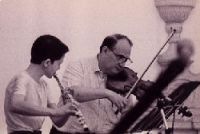
Instrumentalists
- bio
Duo Porta-Morini - Biography
Instrument: Flute - Violin - Ensemble
The Duo formed by Annamaria Morini and Enzo Porta, the only permanent one of its kind, made its debut in 1988. Its presence in the musical panorama has given a new impetus to instrumental research on the part of composers and has led to the creation of a particularly interesting repertoire which today can boast over 40 titles.. The most important composers from various generations have written for them, starting with Riccardo Malipiero, Aldo Clementi, Donatoni and Manzoni.
In addition to their principal activity in the sector of contemporary music, they are interested in the original repertoire of the eighteenth/nineteenth century, discovering rare unpublished pages. They have recorded for Edipan and are at the moment collaborating with Limen for a record and multimedia project of immense scope.
Annamaria Morini devotes herself principally to the various sectors of contemporary music, giving preference to research into new instrumental techniques and to collaboration with composers, in addition to her activity as performer which takes her to prestigious venues both in Italy and abroad. She has given numerous first performances of pieces composed especially for her, both as soloist and in small chamber groups. The extension of her interests towards themes concerning physiology and acoustics has led her in recent years to draw up a series of innovative didactic criteria. She teaches at Bologna Conservatory and is extremely active in seminars and master classes on various subjects. In addition she cultivates, with particular solicitude, the diffusion of contemporary and other musical conceptions as well as of the new prospects of flute technique, publishing papers and articles in specialist periodicals and editing presentations of concerts and other texts of musical information.
Enzo Porta, after protracted periods dedicated in particular to chamber music - first with the Quartetto di Milano and then as first violin of the Società Cameristica Italiana - has in more recent years concentrated on solo work, above all in the field of contemporary music which sees in him one of its most highly-qualified performers. In addition he devotes ample time to didactics (one of his principal interests) through courses and seminars on twentieth-century violin technique and literature and through teaching the instrument. He has published "I suoni armonici del violino. Classificazione e nuove techniche" (Ricordi, 1988), "I movimenti fondamentali della mano sinistra" (Rugginenti, 1995) and "Il violino nella storia" (EDT, 2000). Rugginenti will also be publishing shortly "I movimenti fondamentali della tecnica dell'arco".
Annamaria Morini and Enzo Porta are perhaps the most highly thought-of performers of the contemporary repertoire in the Italian panorama today, both as soloists and in an uncommon form of duo; they are proposing a mixed programme which ranges from the avant-garde experimentations of Giacinto Scelsi (Divertimento III of the Fifties - one of the first pieces belonging to the so-called "second manner" of the composer) to works of the Nineties of Cappelli, Olivero, Manzoni /Frase due for flute and violin) and of Donatoni (who died recently) in whose memory is included Ciglio II, ending with a novelty by a pupil of the Composition Courses (J. Arreguin's Dos).
Updated to 06/2006 In addition to their principal activity in the sector of contemporary music, they are interested in the original repertoire of the eighteenth/nineteenth century, discovering rare unpublished pages. They have recorded for Edipan and are at the moment collaborating with Limen for a record and multimedia project of immense scope.
Annamaria Morini devotes herself principally to the various sectors of contemporary music, giving preference to research into new instrumental techniques and to collaboration with composers, in addition to her activity as performer which takes her to prestigious venues both in Italy and abroad. She has given numerous first performances of pieces composed especially for her, both as soloist and in small chamber groups. The extension of her interests towards themes concerning physiology and acoustics has led her in recent years to draw up a series of innovative didactic criteria. She teaches at Bologna Conservatory and is extremely active in seminars and master classes on various subjects. In addition she cultivates, with particular solicitude, the diffusion of contemporary and other musical conceptions as well as of the new prospects of flute technique, publishing papers and articles in specialist periodicals and editing presentations of concerts and other texts of musical information.
Enzo Porta, after protracted periods dedicated in particular to chamber music - first with the Quartetto di Milano and then as first violin of the Società Cameristica Italiana - has in more recent years concentrated on solo work, above all in the field of contemporary music which sees in him one of its most highly-qualified performers. In addition he devotes ample time to didactics (one of his principal interests) through courses and seminars on twentieth-century violin technique and literature and through teaching the instrument. He has published "I suoni armonici del violino. Classificazione e nuove techniche" (Ricordi, 1988), "I movimenti fondamentali della mano sinistra" (Rugginenti, 1995) and "Il violino nella storia" (EDT, 2000). Rugginenti will also be publishing shortly "I movimenti fondamentali della tecnica dell'arco".
Annamaria Morini and Enzo Porta are perhaps the most highly thought-of performers of the contemporary repertoire in the Italian panorama today, both as soloists and in an uncommon form of duo; they are proposing a mixed programme which ranges from the avant-garde experimentations of Giacinto Scelsi (Divertimento III of the Fifties - one of the first pieces belonging to the so-called "second manner" of the composer) to works of the Nineties of Cappelli, Olivero, Manzoni /Frase due for flute and violin) and of Donatoni (who died recently) in whose memory is included Ciglio II, ending with a novelty by a pupil of the Composition Courses (J. Arreguin's Dos).
